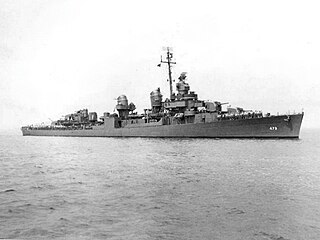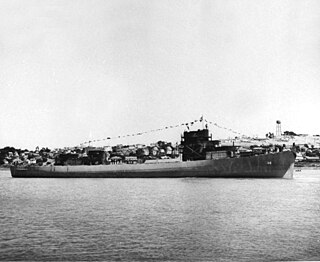
The fourth USS Dale (DD-353) was a Farragut-class destroyer in the United States Navy during World War II. Dale received 14 battle stars for World War II service. She was named for American Revolutionary war hero Richard Dale.

USS Goldsborough (DD-188/AVP-18/AVD-5/APD-32) was a Clemson-class destroyer in the United States Navy during World War II. She was the second Navy ship named for Rear Admiral Louis M. Goldsborough (1805–1877). Entering service in 1920, the ship had a brief active life before being placed in reserve in 1922. Goldsborough was reactivated for World War II and was used as an aircraft tender, destroyer and high speed transport in both Atlantic and Pacific theaters. Following the war, the ship was sold for scrapping in 1946.

USS Williamson (DD-244/AVP-15/AVD-2/APD-27) was a Clemson-class destroyer in the United States Navy during World War II. She was named for Commander William Price Williamson.

USS Bennett (DD-473), a Fletcher-class destroyer, was a ship of the U.S. Navy that was named for the naval aviator Floyd Bennett (1890–1928), who flew towards the North Pole with Richard E. Byrd in 1926, but it is disputed whether they made it there.

USS Pringle (DD-477), a Fletcher-class destroyer, was a ship of the United States Navy named for Vice Admiral Joel R. P. Pringle (1873–1932).

The first USS Noa (DD-343/APD-24) was a Clemson-class destroyer in the United States Navy following World War I. She was named for Midshipman Loveman Noa. At the beginning of World War II she was converted to a High-speed transport and redesignated APD-24.

USS Downes (DD-375) was a Mahan-class destroyer in the United States Navy before and during World War II. She was the second ship named for John Downes, a US Navy officer.

USS Gosselin (APD-126) was a Crosley-class high speed transport of the United States Navy, in service from 1944 to 1949. She was sold for scrap in 1965.

USS Atherton (DE-169), a Cannon-class destroyer escort, was the only ship of the United States Navy to be named for Lt. (jg) John McDougal Atherton, who died when USS Meredith sank near Guadalcanal during World War II.

USS Eisele (DE-34) was an Evarts-class short-hull destroyer escort in the service of the United States Navy.

USS Willis (DE–395) was an Edsall-class destroyer escort of the United States Navy.

USS Gilmore (DE-18) was an Evarts-class short-hull destroyer escort in the service of the United States Navy.

USS Halloran (DE-305) was a Evarts-class destroyer escort of the United States Navy.

USS Sederstrom (DE-31) was a Evarts-class destroyer escort of the United States Navy during World War II. She was promptly sent to the Pacific Ocean to escort convoys and to protect other ships from Japanese planes and submarines. Her assignments took her from one battle area to another, but she was fortunate in remaining almost unscathed by the end of the war. For her efforts in battle areas, she was awarded five battle stars by war's end.

USS Seid (DE-256) was an Evarts-class destroyer escort of the United States Navy in service from 1943 to 1945. She was scrapped in 1947.

USS William C. Miller (DE-259) was an Evarts-class destroyer escort constructed for the United States Navy during World War II. She was sent off into the Pacific Ocean to protect convoys and other ships from Japanese submarines and fighter aircraft. She performed escort and anti-submarine operations in dangerous battle areas and returned home with seven battle stars, a very high number for a ship of her type.

USS Snyder (DE-745) was a Cannon-class destroyer escort built for the United States Navy during World War II. She served in the Pacific Ocean and provided escort service against submarine and air attack for Navy vessels and convoys.

USS Otterstetter (DE-244) was an Edsall-class destroyer escort built for the U.S. Navy during World War II. She served in the Atlantic Ocean the Pacific Ocean and provided destroyer escort protection against submarine and air attack for Navy vessels and convoys.

USS Swenning (DE-394) was an Edsall-class destroyer escort in service with the United States Navy from 1943 to 1946. She was sold for scrapping in 1974.

USS Oswald A. Powers (DE-542) was a United States Navy John C. Butler-class destroyer escort launched during World War II but never completed.




















